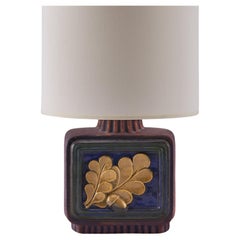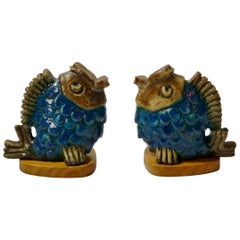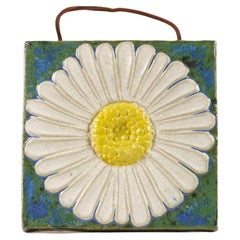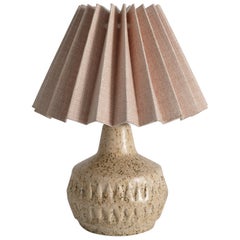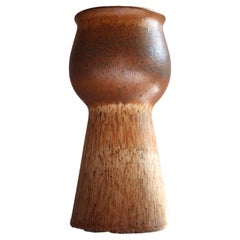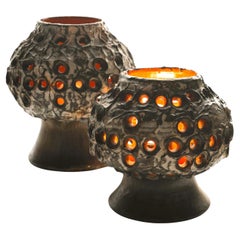Willi Fischer
Mid-Century Willi Fischer vintage table lamp
Located in Matosinhos, 13
Mid Century lamp base by Willi Fischer fir EGO Fischer 1960s studio art pottery. This Lamp has a
Category
Vintage 1960s Swedish Mid-Century Modern Table Lamps
Materials
Ceramic
Pair of Stoneware Fish Figures by Willi Fischer, Sweden, 1970s
Located in Barcelona, ES
A pair of stoneware fish figures by Willi Fischer for his own company Fischer Stengods, Sweden
Category
Mid-20th Century Swedish Scandinavian Modern Animal Sculptures
Materials
Stoneware
$720 / set
H 5.12 in W 2.37 in D 5.52 in
Stoneware Daisy Relief Tile by Willi Fischer, Sweden, 1960s
By Ego Stengods
Located in MAASTRICHT, LI
Decorative stoneware wall plaque by Willi Fischer, produced in Sweden during the 1960s. The relief
Category
Vintage 1960s Swedish Scandinavian Modern Decorative Art
Materials
Earthenware, Stoneware
Mid-Century Modern Brown Speckled Stoneware Table Lamp by EGO, Sweden 1960s
By Bruno Karlsson, Ego Stengods
Located in Grythyttan, SE
desired.
ABOUT EGO
EGO Stengods was founded in 1965 by Gösta Olofsson and German-born artist Willi
Category
Vintage 1960s Swedish Mid-Century Modern Table Lamps
Materials
Stoneware
Recent Sales
Vase by Bruno Karlsson for Ego, Sweden, 1970s
By Ego Stengods, Bruno Karlsson
Located in Skarpnäck, SE
Lundgren and Willi Fischer, among others. The factory first focused on household items, but in the 1960s
Category
Vintage 1970s Swedish Mid-Century Modern Vases
Materials
Ceramic, Stoneware
Brutalist Mid-century modern pottery table lamps by Bruno Karlsson EGO, Sweden.
By Ego Stengods, Bruno Karlsson
Located in Skarpnäck, SE
Willi Fischer, among others. The factory first focused on household items, but in the 1960s also began
Category
Vintage 1950s Swedish Mid-Century Modern Table Lamps
Materials
Ceramic
Mid-century modern pottery table lamp by Bruno Karlsson, EGO, Sweden.
By Ego Stengods, Bruno Karlsson
Located in Skarpnäck, SE
. The designers and ceramicists who worked there included Tyra Lundgren and Willi Fischer, among others
Category
Vintage 1950s Swedish Mid-Century Modern Table Lamps
Materials
Ceramic
Brutalist Brown Stoneware Table Lamp by EGO, Sweden 1960s
By Ego Stengods, Bruno Karlsson
Located in Grythyttan, SE
-born artist Willi Fischer. Olofsson, who had worked in sales at both Gustavsberg and Rörstrand
Category
Vintage 1960s Swedish Mid-Century Modern Table Lamps
Materials
Stoneware
People Also Browsed
Organic Modern Small Table Lamp Natural Wood Handmade Ivory Fluted Shade
By Isabel Moncada
Located in San Antonio, TX
PATA DE ELEFANTE SMALL table lamp was designed for the Atomic collection by Mexican artist Isabel Moncada.
Named Pata de Elefante –Elephant's Foot– for the prominent shape at its ba...
Category
21st Century and Contemporary Mexican Mid-Century Modern Table Lamps
Materials
Wood, Fabric, Linen, Fiberglass
$2,500 / item
H 29 in Dm 19 in
Set Antique Vintage Acorn Opaline White Milk Glass Ceiling Pendant Light Lamp
Located in Sale, GB
- A fabulous run of church opaline acorn pendant lights with steel galleries, circa 1950.
- Wear commensurate with age, all in excellent condition, the steel galleries are aged worn...
Category
Mid-20th Century British Chandeliers and Pendants
Materials
Glass
$1,232 / item
H 13.39 in W 10.63 in D 10.63 in
J. T. Kalmar Brass and Wood Table Lamp
By J.T. Kalmar
Located in Montréal, QC
J. T. Kalmar brass and wood table lamp. 60 watts E-26 Edison medium base incandescent bulb recommended or higher if LED/CFL.
Category
Vintage 1950s Austrian Mid-Century Modern Table Lamps
Materials
Brass
LU Louis SM Sconce
By Lumfardo Luminaires
Located in Los Angeles, CA
The handsome LU Louis SM Sconce is a smaller version of our LU Louis Sconce, an all brass wall sconce in lightly patinated brass with patterned perforations by Lumfardo Luminaires. M...
Category
21st Century and Contemporary American Scandinavian Modern Wall Lights a...
Materials
Brass
Tilgmans Keramik, Table Lamp, Glazed Stoneware, Sweden, 1960s
By Tilgmans Keramik
Located in High Point, NC
A brown, glazed stoneware table lamp designed and produced by Tilgmans Keramik, Sweden, 1960s.
Sold without lampshade.
Dimensions of lamp (inches) : 9 x 4 x 4 (H x W x D)
Dime...
Category
Vintage 1960s Swedish Mid-Century Modern Table Lamps
Materials
Stoneware
Azucena “Luigi Caccia Dominioni “LS1 Chandeliers Brass Glass 1950 Italy
By Luigi Caccia Dominioni
Located in Milano, IT
Azucena Chandelier
Category
Vintage 1950s Italian Other Chandeliers and Pendants
Materials
Brass
Elegant Set of Six French Art Deco Oak Chairs, 1940s, Bouclé
By Jacques Adnet
Located in Split, Splitsko-dalmatinska županija
Introducing a captivating set of six French Art Deco dining chairs from the 1940s, expertly crafted in solid oak. This exceptional ensemble features an artful blend of both curved an...
Category
Vintage 1940s French Art Deco Dining Room Chairs
Materials
Oak
$7,800 / set
H 38.19 in W 17.33 in D 16.15 in
ASEA mid-century wall lamp by Bo Råman, brass oak & glass, Sweden 1950s
By ASEA, Bo Råman
Located in Forserum, SE
A mid-century modernist wall lamp designed by Bo Råman and produced by the Swedish lighting manufacturer ASEA Belysning in the 1950s. Crafted from brass, it features a bowl-shaped gl...
Category
Vintage 1950s Swedish Scandinavian Modern Wall Lights and Sconces
Materials
Brass
$1,441
H 9.45 in W 7.09 in D 18.9 in
Guillerme et Chambron Votre Maison Large Oak Dining Table, France 1960's
By Guillerme et Chambron
Located in New York, NY
Large Guillerme & Chambron table for Votre Maison. Solid oak top with a double wishbone stretcher linking the legs. Original finish and patina.
Category
Mid-20th Century European Mid-Century Modern Dining Room Tables
Materials
Oak
$17,500
H 26 in W 75 in D 37 in
Contemporary Italian Brutalist Wood And Travertine Sideboard
Located in London, London
Sideboard
Travertine top
Brass handles
Brutalist
Contemporary
One in stock but can be made to order
Made in a small workshop in Italy
Category
21st Century and Contemporary Italian Mid-Century Modern Sideboards
Materials
Travertine
$5,914 / item
H 33.86 in W 73.63 in D 19.69 in
1960s Slate, Concrete and Oak Brutalist Coffee Table
Located in London, London
Coffee table
Brutalist
Slate and stone on concrete top
Oak and iron base
Belgian 1960s/1970s
Category
Mid-20th Century Belgian Brutalist Coffee and Cocktail Tables
Materials
Concrete, Slate, Iron
Scandinavian Coffee Table with Trapezium Base in Solid Oak
Located in Waalwijk, NL
Coffee table, oak, Scandinavia, 1970s
This elegant solid oak coffee table was designed in the 1970s. It showcases a beautifully crafted round tabletop, supported by a distinctive tr...
Category
Vintage 1970s Scandinavian Scandinavian Modern Coffee and Cocktail Tables
Materials
Oak
Rug & Kilim’s Scandinavian Style Kilim in Blue and Beige-Brown Geometric Pattern
By Rug & Kilim
Located in Long Island City, NY
A smart 9x12 Swedish style kilim from our award-winning Scandinavian flat weave collection. Handwoven in wool.
Further On the Design:
This rug enjoys a defined movement with cris...
Category
2010s Indian Scandinavian Modern Russian and Scandinavian Rugs
Materials
Wool
$8,213
W 108 in L 146 in
Jade Coffee Table h46 by Draga & Aurel Resin and Brass, 21st Century
By Draga & Aurel
Located in Como, IT
Jade coffee table features ethereal transparency and a reflective surface that plays naturally with light. The brightly colored table top rests on a cylindrical brass base, whose dis...
Category
21st Century and Contemporary Italian Modern Coffee and Cocktail Tables
Materials
Brass
$6,592 / item
H 18.12 in W 19.69 in D 19.69 in
Rarest Mid Century Cardboard Table Lamp! Gregory Van Pelt Frank Gehry Art 1960s
By Gregory Van Pelt, Frank Gehry
Located in Peoria, AZ
Wow!
Rarest Mid Century
Cardboard Table Lamp
By Gregory Van Pelt
Here is a fantastic and simply beautiful example of the card board lamp by Gregory Van Pelt! The base of this lam...
Category
Mid-20th Century American Mid-Century Modern Table Lamps
Materials
Paper
$3,200 Sale Price
20% Off
H 18 in W 14 in D 14 in
Japanese Ceramic Vase Mingei Style Hamada Shoji
By Hamada Shoji
Located in Atlanta, GA
A heavily potted stoneware vase in cylindrical form, decorated with abstract strokes in iron rust glaze (known as Persimmon Glaze in Japanese) on a black glazed background. The patte...
Category
Late 20th Century Japanese Arts and Crafts Ceramics
Materials
Ceramic
Get Updated with New Arrivals
Save "Willi Fischer", and we’ll notify you when there are new listings in this category.
More Ways To Browse
Orrefors Carafe
Orrefors Stella
Osolnik Originals
Our Lady Statue
Pagan Buddha
Painted Chest Bird
Painted Dry Sink
Painted Sea Chest
Painted Wedding Box
Pair Malachite Urns
Pair Marble Top Dressers
Pair Of Korean Cabinets
Pair Pedestals Black Gold
Pair Porcelain Bird Figures
Paisley Vase
Pakistan Chest
Palace Size Urns
Palaset Palanox
